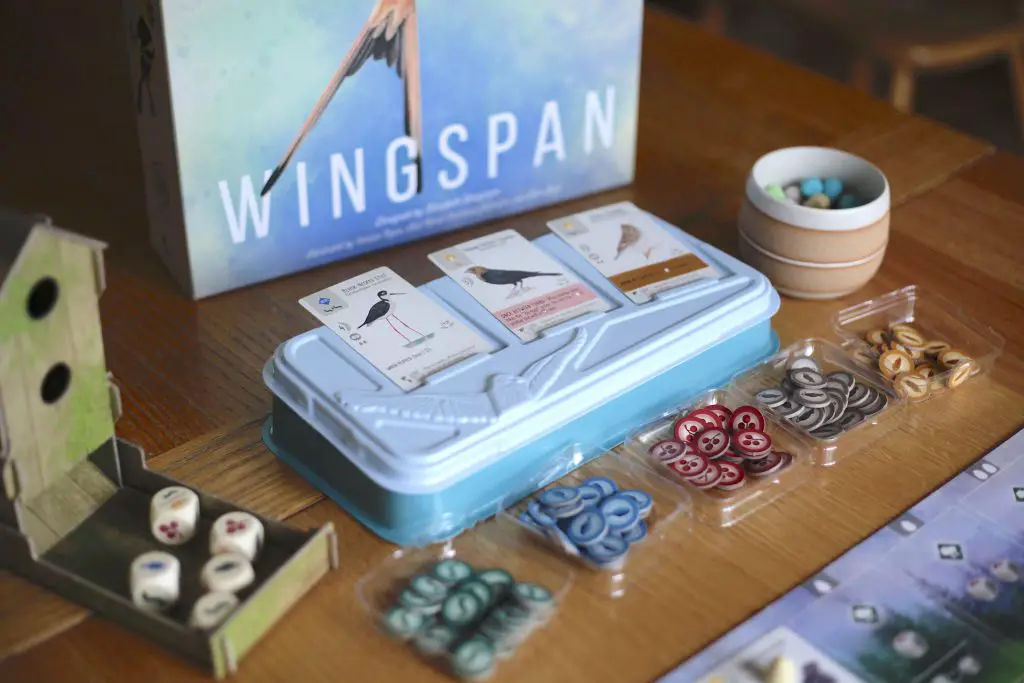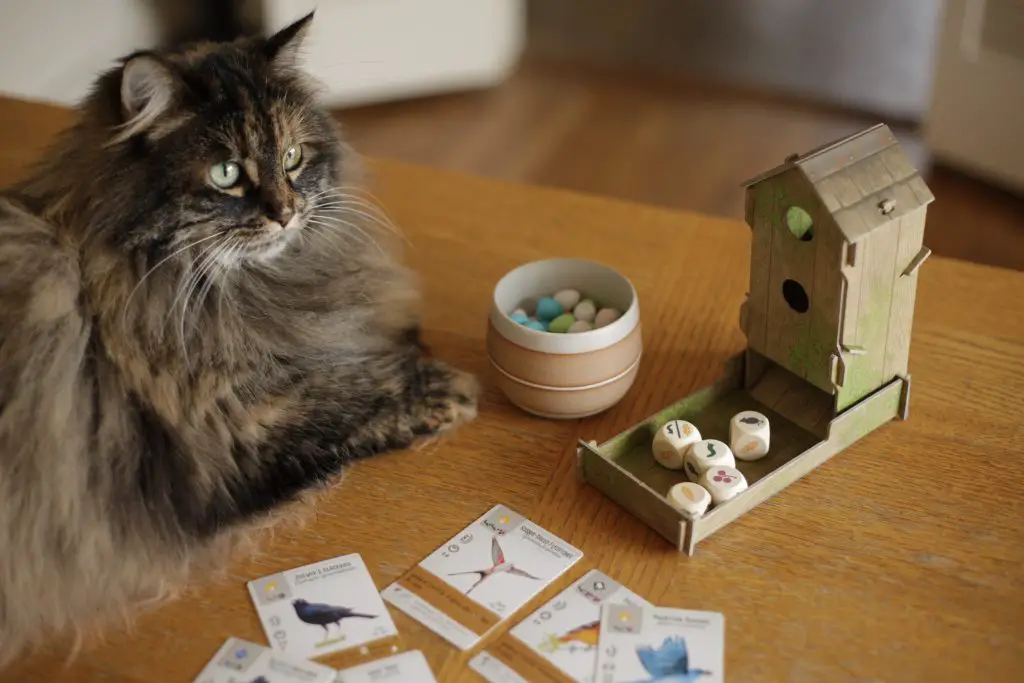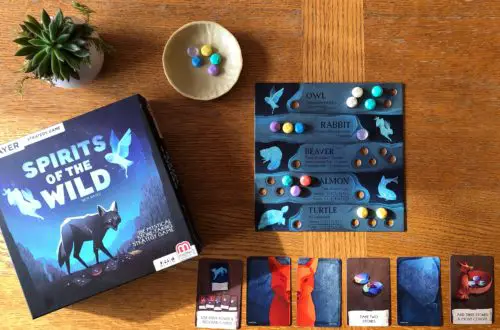12 Wingspan Strategy Tips for Your Best Game Every Time
Hey there! This website does contain affiliate links. If you purchase something through this page, Cats and Dice may earn a share of sales from the link. Learn more.
Who knew that an in-depth board game about birds could be so fun? Elizabeth Hargrave did. An avid bird watcher and board gamer, she turned her two passions into the educational and compelling board game, Wingspan. And this is not an easy game! Unlike simple childhood favorites like Monopoly and Uno, Wingspan has expansions, and Wingspan strategy tips can seriously help your gameplay.
As someone who has over 200 hours played on the digital edition of Wingspan as of 2025, including the European expansion and the Oceania expansion, I hope to give you guidance not only on the best Wingspan strategy tips but also on how to have as much fun with it as I have.
How to Play Wingspan
This article does not cover how to play. Instead, this is a Wingspan strategy guide filled with Wingspan strategies to help you out after your first few playthroughs. For a guide on how to play, check out the video below. Make sure to get your copy of Wingspan before you watch!
The latest edition of Wingspan also includes the “Swift Starter Pack,” complete with unique cards and recommended turns. It is another excellent way to learn how to play Wingspan.
The rulebook is also quite comprehensive and well-organized. Paired with the appendix, you’ll be able to learn how to play Wingspan quite quickly.
Similarly, you can get the digital edition of Wingspan and learn how to play without needing to find a game group!
Related Post: The Best Solo Board Games You’ll Ever Play

Wingspan Strategy Tips
Now that you know how to play, use these Wingspan strategy tips to learn how to win. It will take a couple more playthroughs to get the hang of each of these. Wingspan also involves a bit of luck, so remember that not every tip will work every time in this Wingspan strategy guide. Still, each tip will go a long way towards helping you win Wingspan.
Tip #1: Focus on One or Two Habitats to Build an Engine
Wingspan is what is known as an “engine builder” in the board game world. When you build an “engine” in board games, you are essentially making moves that will give you greater resources and/or points. You will start out with very little, and what you choose will get you greater rewards.
To build a successful engine in Wingspan, you need to start early. You will also want to pair your engine with other tips in this Wingspan strategy guide, so consider the following:
- What bird cards you already have and their activation powers.
- Your bonus cards and what habitat engines will pair well.
- The end of round bonuses in play.
You also only want to focus on one or two habitats. The Forest is more helpful row early in the game for food, while the Grasslands are most helpful near the end for eggs.
One of the most powerful engine-building strategies, if you can pull it off, is to play birds with one kind of power in a different row. For example, if you can play a lot of birds that get you new cards in the “food” engine, then you almost never will need to take the “Draw Bird Cards” action. You’ll be able to skip a lot of steps and gain “free” turns.
Another strategy I like to use is to have a Once Between Turns card that helps me in a limited resource. For example, if I don’t have a lot of birds to play in the Grasslands, a bird like a Cuckoo will allow me to play eggs when a different player takes the Lay Eggs action. This strategy can be fickle depending on the exact power as noted in Tip #10, but powers that are triggered by common plays like laying eggs pays off.
Tip #2: Pay Attention to the Bonus Cards
While you do not have to complete the Bonus Card you receive at the beginning of the game (or any Bonus Card you get), it can help you structure your strategy. A Bonus Card you start out with might fit very well into your starting hand. The points you gain might also be the tipping point in the game.
Consider the percent of cards that can achieve that goal when choosing your starting Bonus Card. Then, counter it against the cards you are dealt and the End of Round Bonuses in play. If one Bonus Card stands out as something you can easily achieve, keep that one. Otherwise, choose the one with the greater percentage of cards that meet that bonus to increase your odds. If a Bonus Card doesn’t list a percentage of cards, then it’s likely that it scores points per card played. This is a great way to sneak in a few extra points.
If you have an opportunity to get extra bonus cards, go for it if it fits into your overall strategy. You don’t lose anything by not completing one, but a lot can be gained.
Tip #3: Don’t Pay Too Much Attention to Bonus Cards
With that said, don’t focus so much on completing your bonus that you ignore strategies that can earn more points, like in the tips that follow. Bonus Cards usually can earn you no more than 7 points in a game where you’ll want to aim for at least 80 points to win. Eggs alone can get you 1 point each, and some bird cards are worth more than 7 points alone. Your attention might be better focused elsewhere.
This applies to End of Round Bonuses, too, especially early on. If working towards a certain goal would break the rest of your strategy, don’t bother. The point difference between players is not that great, so first versus third place most likely won’t change the end results.
Remember, these are bonuses. They are intended to extra points, not the main source of points. They’re best used as a way to eliminate decision fatigue in your strategy planning, not as the main focus in your strategy.

Tip #4: Mix High-Point and Low-Point Birds
You may have noticed in your first few playthroughs that the lower-point birds have stronger powers. These often build well into an engine. Start with these powerful lower-point cards. Then, add a few high-point birds along the way.
For example, playing birds that get you a lot of food won’t amount to a lot of points in the end. Instead, play that bird early on. Then, use the extra food gained to play an extra bird at the end that has higher points and/or can lay a lot of eggs.
Sometimes it’s just luck of the draw, so if you don’t get a lot of good engine-building birds early on, you might want to try to get some with the Draw Cards action. Or, you might base your strategy on playing high-point birds that earn bonuses instead. It’s not ideal to plan to play a lot of high-point birds, though, without a strong engine. They tend to cost a lot of food, and if you can’t get a lot of food, you might end up stuck.
Tip #5: Play Birds That Allow You to Get New Cards
As you might have figured out from the previous Wingspan strategy tip, the more bird cards you can get early on, the more options you will have strategy-wise. But you don’t want to spend too many turns on the Draw Cards action either unless you’ve got a nice engine going there.
By building an engine that allows you to get new cards, you will have a lot of choices in the long run. In addition to having lots of choices for what to pay that will help with most of the tips on this list, you will have the ability to get rid of cards in helpful ways like tucking.
Tip #6: Ravens and Crows are Overpowered, So Play Them!
Ravens and crows go a long way towards enacting the previous tips on this list of Wingspan strategy tips. Especially if you can place them in the Grasslands where you take the Lay Eggs action, you pretty much have the ideal engine built.
That’s because ravens and crows allow you to trade eggs for food or cards. So if you’re gaining eggs in a turn and then using them to gain things you need, you pretty much never need to take any other action other than playing birds.
Tip #7: Don’t Forget to Trade Food
This one has knocked me down a peg more than once. Don’t forget that you can use any two food in place of one. This helps a lot if a bird power allows you to stockpile one type of food. It’s also a great way to sneak in some extra points by playing any random bird cards you have near the end of the game. Depending on the kind of engine you’ve built, this may be more powerful than taking the Lay Eggs action for your last few turns.
Remember, unused food and unplayed bird cards do not help you at the end of the game (unless you have a bonus that says otherwise.) The next few Wingspan strategies dig into this a little more. That’s why, though, you’ll want to use as much food as you can during the game.
And while you’re at it, the resources boxes provided in the game aren’t the best. Give yourself an upgrade with this beautiful resource organizer.
Tip #8: Lay Eggs, Tuck Cards
Laying eggs and tucking cards, especially in Round 4, can rack up the points very quickly. Each egg and tucked card is worth 1 point each. So if you can get even three eggs in a turn, those extra points can make or break the game.
You can also cache food for 1 point each, but in my personal experience, this power has not consistently yielded as many points as eggs or tucking. It seemingly lacks the consistency of the other two powers. Some cards, however, will allow you to discard one type of food to tuck two cards, for example. If you have a surplus of that food for any reason, this strategy can pay off very quickly.
In other words, be very mindful of what your previously played birds can already do when it comes to gaining resources and how that might interact with any future birds you play.
Tip #9: Pay Attention to Other Players
Your plays can sometimes help other players depending on your bird powers. Keep an eye on the other players to see if the move you want to make will be canceled out by helping someone else more than it helps you.
For example, some bird powers will give every player a berry or an extra card. If another player has desperately been waiting to roll a berry but you do not need one, then don’t activate the bird power.

Tip #10: Beware Cards that Rely on Luck
Similarly, be careful of playing cards that rely on other players. They’re not necessarily bad, but other players may be wary of taking plays that help you. Pink power cards that indicate the In-Between Turns power activation are unreliable at best for this reason. They are best played as a small part of your larger overall strategy and very early in the game. If a pink card allows you to complete one of your bonuses or gives you eggs or food, it could be worth it.
Skull cards pose a similar problem. If you can’t get a roll or card you need to gain the power, these cards can be a loss. In other words, treat them like Bonus Cards as discussed in Tip #3. They can add some much-needed points, but basing your strategy off of them will not help you win.
Tip #11: Wild Nest Birds Work Toward Any Bonus or Goal
Birds with a star in place of a nest can be incredibly powerful. Wild nests can count toward any bonus that involves a nest. These include bonuses that call for “Most eggs in X nest” or “Most birds with eggs in X nest.” They also work towards end of round goals.
In the base game, a wild nest always acts as another kind of nest for bonus cards. The exception is in the Oceania expansion. Some bonus cards there only allow you to count wild nests once. Therefore, you’ll need to count what you have.
Tip #12: Practice Against the Automaton
The solo mode for Wingspan, also known as the Automaton, isn’t just great for individual fun. It can be a great way to practice these Wingspan strategy tips, too.
The Automaton is balanced well for different difficulty settings, so your score compared to its score will give you a good sense of how well you’re understanding the game. Think of it like competing against a computer player in virtual gameplay.
And speaking of virtual gameplay, did you know you can play Wingspan online? It’s another great way to practice these Wingspan strategies.
Time to Win Wingspan!
Make sure to bookmark this Wingspan strategy guide to help you win Wingspan again and again. Make sure to come back, too, once this Wingspan guide is updated for the Asia expansion. It will take some time to get the hang of all these Wingspan strategy tips. Fortunately, the learning curve is incredibly fun to overcome.
While you’re at it, make sure to get a nice Wingspan organizer to help you store your game. The guide on the side of the box helps, but since you’re certain to play Wingspan more and more with these tips, you’ll want something that’s consistently easy to put away and organize.
Hi there! I’m Kristen. I’m a game writer, a Dungeon Master, and like you, I love tabletop games. Visit our About page to learn more about me.
I wrote this Cats and Dice article to help you enjoy gaming even more. Did it help? If so, our kitties (and our site) would be grateful for a little gift through Ko-Fi.




